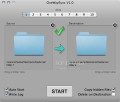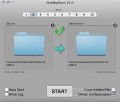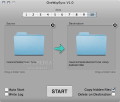The easy or the hard way, we have all learned that backing up data is essential, and that there are at least two aspects to consider when doing so: speed and frequency. OneWaySync tries to meet both requirements while keeping things simple.
Storing backups on multiple locations in order to prevent data loss is by far a common practice nowadays. The launch of Mac OS X 10.5 Leopard, having the Time Machine application among the default utilities, and the recently launched iCloud service are vivid testimonies to just how serious the matter is.
The differences between the two Apple tools are obvious. In concept, Time Machine is mostly intended to keep your data safe, while iCloud raises another important issue: accessibility. Still, either of them are not universal solutions, and OneWaySync is a small tool designed to fill some of the gaps.
The Looks
OneWaySync is the type of application that can be used successfully without reading the documentation: all the features are accessible from the main and are mostly self explanatory. Basically, there are 10 slots, which means that you can have up to 10 folders synchronized.
Each time a slot is selected, the central area of the main window will display the assigned folders pair (the source on the left and the destination on the right). Of course, you will have to make the initial setup, but the process is reduced to a simple drag and drop.
On the bottom, you can see the extra functions and, to activate/disable them a quick check/uncheck is enough. The synchronization can be triggered automatically when the application is launched, but the big Start button gives you the possibility to do it manually, whenever you need to.
The Works
OneWaySync’s workflow is relying on basic skills that should not pose any problems, although there are certain functions that require your attention to make the most of them. First of all, notice that the check boxes on the bottom can have different values for each slot, so make the necessary adjustments for each folders pair.
Checking the Auto Start box means that the syncing will be performed at launch, but it’s not efficient to have the application running at start up, or at least, not just then. The developer suggests that you can have OneWaySync launched automatically using an iCal alarm.
I could go further and say that you should also activate Spaces, assign it to one that you do not use frequently, and this way you will not be bothered by the popping window. This could work perfectly if OneWaySync would have the capability to scan the folders for changes and take the appropriate measures.
Since this is not the case, having OneWaySync around at all times proves to be vital to stay on top all the changes, and manually sync your folders when this is the case. On the other hand, the Auto Start feature is the only way to batch sync folders and, to take effect, make sure it is selected for each folders pair individually.
When the synchronization process is done, you will be announced by the popping of a check mark between the two folders. To know exactly with which folders are you working, underneath each one you can see the folder path, while double clicking on it will launch a Finder window containing the respective folder.
To keep track of the changes you can enable the Write Log function and each sync will generate a text file stating what, when and where was copied. The files can be found in the OneWaySync folder that is automatically generated in the default Documents directory.
Unfortunately, the logs are not grouped by slots: the auto generated names only take into account the date and time, which makes it difficult to follow the changes performed on a specific folder.
During sync, OneWaySync is also able to remove from the destination folder the files that you have deleted from the source folder, if the Delete on Destination box is checked. Obliviously, the box should be unchecked if you want to combine several folders.
I believe that the most useful OneWaySync feature is Copy Hidden Files, which allows you to create an exact copy of a certain folder. This will prove to be useful if you want to create a duplicate of your iTunes or iPhoto library.
The Good
The Bad
The developer does not offer a lite or trial version and the application is only available through the App Store. This means that on top of a license you need an Intel Mac running at least Mac OS X 10.6.6 and an AppStore account.
I must confess that it would be a lot more impressive if OneWaySync could be able to monitor the source folder and automatically sync when needed. Frequency is a quite important thing when it comes to backups and any alternative solution, like a sync scheduler perhaps, is most welcomed.
The Truth
Here are some snapshots of the application in action:
 14 DAY TRIAL //
14 DAY TRIAL // 


